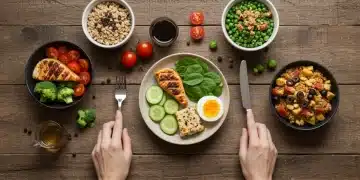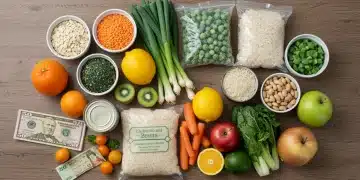Meal Prepping for Busy Weeks: Healthier Eating Guide
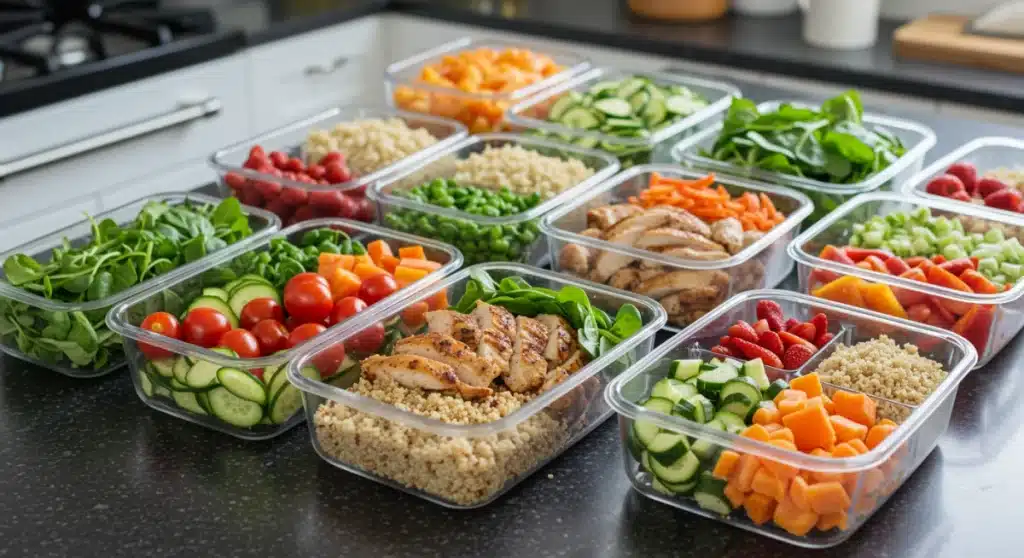
Meal prepping for busy weeks offers a practical solution to maintain healthy eating habits by preparing meals in advance, reducing daily cooking stress and promoting consistent nutritional intake.
Life often feels like a relentless sprint, especially when balancing work, family, and personal well-being. In this fast-paced world, maintaining a healthy diet can seem like an insurmountable challenge. However, with strategic planning and a bit of foresight, achieving your nutritional goals is entirely within reach. This guide delves into how Meal Prepping for Busy Weeks: A 3-Step Guide to Healthier Eating (PRACTICAL SOLUTIONS) can transform your approach to food, making healthy eating not just a possibility, but a convenient and enjoyable reality.
Understanding the Power of Meal Prepping
Meal prepping is more than just cooking in advance; it’s a lifestyle strategy designed to streamline your dietary habits, save time, and promote consistent healthy eating. It involves planning your meals, shopping for ingredients, and preparing components or entire dishes ahead of time, typically for the week ahead. This proactive approach eliminates the daily scramble of deciding what to eat, reducing the likelihood of impulse purchases or relying on less healthy takeout options.
The core benefit of meal prepping lies in its ability to empower you to take control of your diet. By preparing nutritious meals when you have the time, you ensure that healthy options are readily available, even on your busiest days. This not only supports physical health but also offers a significant mental reprieve, knowing that a wholesome meal is just a reheat away. For many, it’s a crucial step towards sustainable healthy eating and a more balanced life.
Why Meal Prepping is Essential for Busy Lifestyles
In today’s demanding environment, time is a precious commodity. Meal prepping directly addresses this by consolidating cooking efforts into one or two dedicated sessions. Instead of cooking every night, you prepare meals once, freeing up evenings for other activities or relaxation. This efficiency is a game-changer for anyone with a packed schedule.
- Time Efficiency: Consolidate cooking time, freeing up evenings.
- Cost Savings: Reduce impulse buys and food waste by planning.
- Healthier Choices: Ensure nutritious meals are always on hand.
- Stress Reduction: Eliminate daily mealtime decision-making.
Beyond time and cost, meal prepping fosters a healthier relationship with food. It encourages mindful eating and helps you understand portion control. When you actively participate in preparing your food, you become more aware of the ingredients and nutritional content, leading to better dietary choices overall.
Ultimately, understanding the power of meal prepping is recognizing its potential to simplify your life while enhancing your health. It’s about making conscious choices that support your well-being, even when life gets hectic. This foundational understanding sets the stage for a successful meal prep journey.
Step 1: Planning Your Weekly Menu and Shopping List
The first and arguably most critical step in successful meal prepping is meticulous planning. This isn’t just about jotting down a few ideas; it’s about creating a coherent and delicious menu that aligns with your dietary goals and schedule. A well-thought-out plan sets the foundation for an efficient cooking session and ensures you have all the necessary ingredients on hand.
Begin by assessing your week. Consider how many meals you need to prep (breakfasts, lunches, dinners, snacks) and factor in any social engagements or planned takeout nights. This helps prevent over-prepping or under-prepping. Once you have a clear picture, start brainstorming meal ideas. Look for recipes that use similar ingredients to minimize waste and simplify your shopping. Variety is key to avoiding meal fatigue, so try to incorporate different proteins, vegetables, and grains throughout the week.
Crafting a Strategic Menu
When crafting your menu, think about meals that are versatile and hold up well in the refrigerator. Dishes like grain bowls, stir-fries, casseroles, and roasted vegetables are excellent choices. Don’t forget to include a balance of macronutrients – proteins, carbohydrates, and healthy fats – to keep you energized and satisfied. Consider theme nights, such as ‘Taco Tuesday’ or ‘Pasta Wednesday’, to add structure and fun to your planning process.
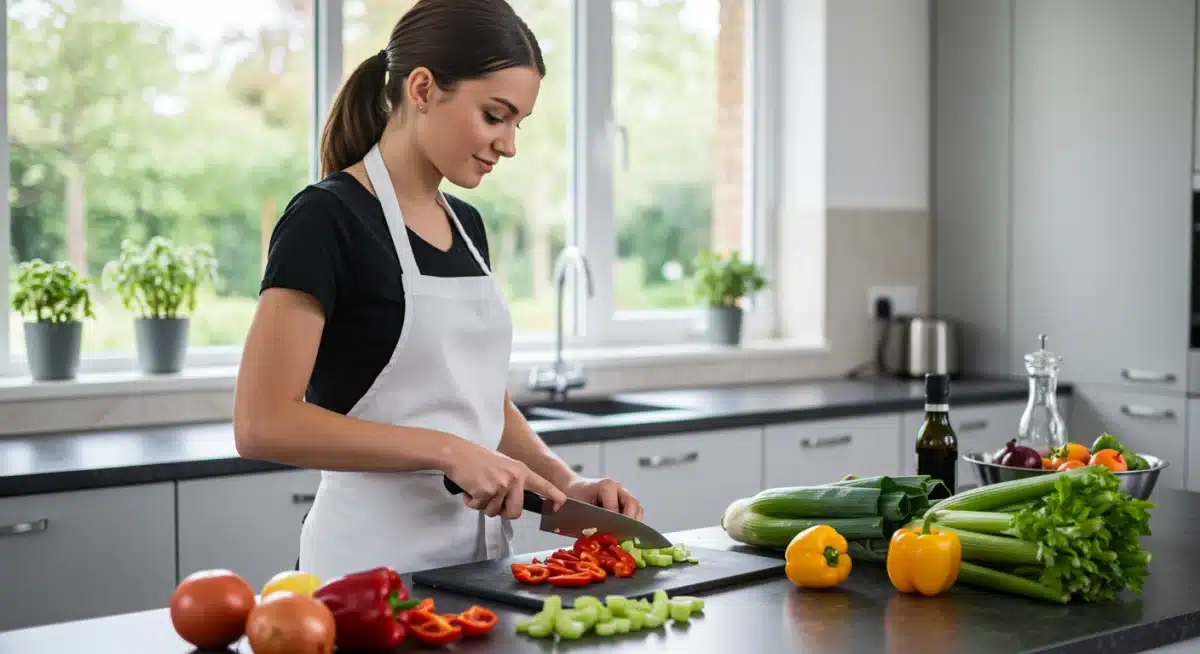
Once your menu is solidified, it’s time to create your shopping list. Go through each recipe and list every single ingredient you’ll need, including spices and condiments. Cross-reference this list with items you already have in your pantry to avoid unnecessary purchases. Organize your list by grocery store sections (produce, dairy, meat, pantry) to make your shopping trip as quick and efficient as possible.
- Assess Your Week: Determine meal needs and existing plans.
- Choose Versatile Recipes: Opt for dishes that store well and offer variety.
- Balance Macronutrients: Ensure a mix of protein, carbs, and healthy fats.
- Organize Shopping List: Group items by store section for efficiency.
A strategic menu and a well-organized shopping list are your blueprints for success. They eliminate guesswork, reduce stress, and ensure you have everything required to execute your meal prep plan flawlessly. This initial planning phase is an investment that pays dividends throughout your busy week.
Step 2: Efficient Cooking and Preparation Techniques
With your menu planned and groceries purchased, the next step is the actual cooking and preparation. This is where efficiency becomes paramount. Approaching your cooking session with a systematic mindset can significantly reduce the time spent in the kitchen and make the entire process more enjoyable. Think of it as a culinary assembly line, where each task flows seamlessly into the next.
Start by gathering all your ingredients and equipment. This mise en place approach ensures you have everything within reach, preventing last-minute searches and interruptions. Begin with tasks that take the longest or require oven space, such as roasting vegetables or baking chicken. While those are cooking, you can move on to chopping other ingredients, preparing sauces, or cooking grains like quinoa or rice.
Batch Cooking and Smart Storage
Batch cooking is a cornerstone of efficient meal prepping. This involves cooking larger quantities of staple ingredients that can be used in multiple meals throughout the week. For instance, you can roast a large tray of vegetables, grill a batch of chicken breasts, or cook a big pot of rice. These components can then be mixed and matched to create diverse meals, preventing monotony.
Proper storage is just as crucial as efficient cooking. Invest in high-quality, airtight containers that are microwave-safe and stackable. Glass containers are often preferred for their durability and lack of chemical leaching. Allow all food to cool completely before portioning and storing it in the refrigerator to prevent bacterial growth and maintain freshness. Clearly label containers with the meal name and date of preparation to keep track of freshness.
- Mise en Place: Organize ingredients and equipment before starting.
- Prioritize Tasks: Begin with longer-cooking items first.
- Batch Cook Staples: Prepare large quantities of versatile ingredients.
- Use Airtight Containers: Ensure freshness and prevent spoilage.
Employing efficient cooking techniques and smart storage solutions transforms meal prep from a chore into a rewarding and manageable process. By maximizing your time in the kitchen and preserving the quality of your food, you ensure that your healthy meals are ready to enjoy whenever hunger strikes, making Meal Prepping for Busy Weeks a truly practical solution.
Step 3: Assembling and Storing Your Prepped Meals
After the cooking is done, the final step in your meal prepping journey is assembling and properly storing your meals. This phase is critical for maintaining food safety, maximizing flavor, and ensuring your prepped meals are appealing and convenient throughout the week. A well-organized storage system will make grabbing a healthy meal as effortless as possible.
Once your cooked components have cooled down, begin portioning them into your chosen containers. Think about the balance of macronutrients for each meal. For example, a typical lunch might include a portion of protein (chicken, tofu), a serving of complex carbohydrates (quinoa, sweet potato), and a generous amount of vegetables. Layering ingredients can also help prevent sogginess; for instance, keep dressings separate until just before eating, or place greens on top of cooked components.
Optimizing Storage for Freshness and Convenience
The type of container you use plays a significant role in how long your food stays fresh. Glass containers with airtight lids are excellent for preserving flavor and preventing leaks. For dry snacks or smaller portions, reusable silicone bags or smaller containers can be useful. Consider investing in containers that are specifically designed for meal prepping, often featuring multiple compartments to keep different food items separated.
Refrigeration is key for maintaining freshness. Most prepped meals will last safely in the refrigerator for 3-4 days. For meals intended for later in the week, consider freezing them. Soups, stews, casseroles, and even some cooked grains and proteins freeze exceptionally well. When freezing, ensure containers are freezer-safe and leave a little headspace for expansion. Proper labeling with the date is essential for both refrigerated and frozen items.
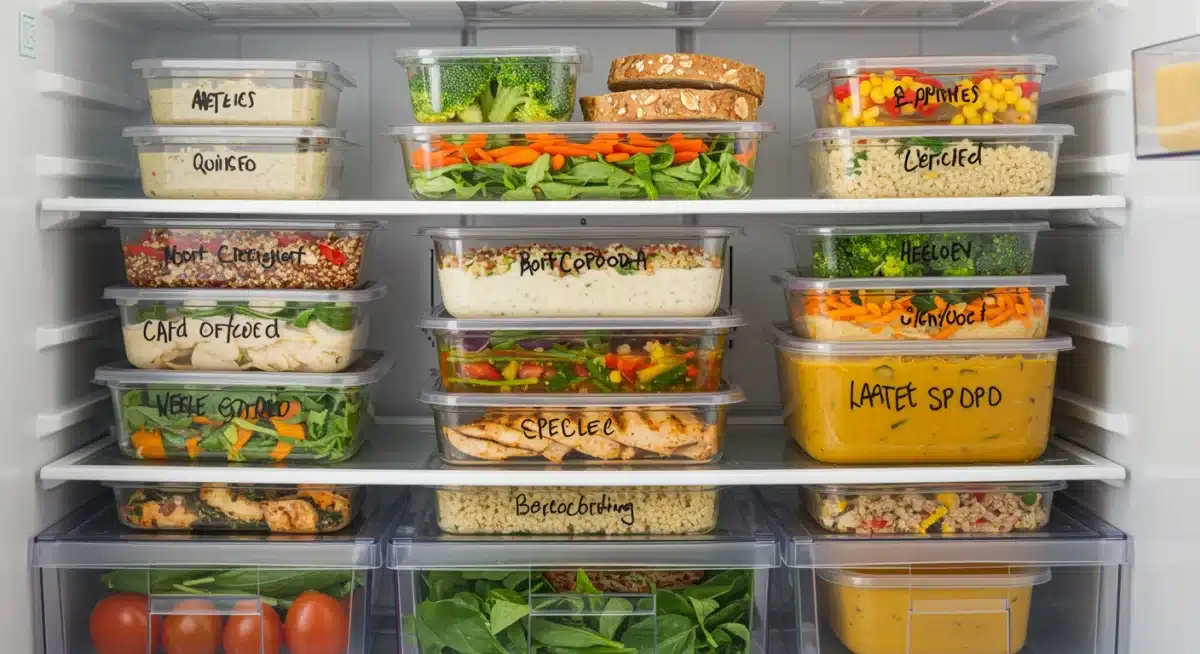
- Portion Mindfully: Balance macronutrients in each container.
- Prevent Soggy Meals: Layer ingredients and store dressings separately.
- Choose Quality Containers: Opt for airtight, microwave-safe, stackable options.
- Refrigerate or Freeze: Store appropriately based on consumption timeline.
By carefully assembling and storing your prepped meals, you are effectively setting yourself up for a week of effortless, healthy eating. This final step ensures that all your hard work in planning and cooking translates into convenient, delicious, and nutritious meals, embodying the true spirit of Meal Prepping for Busy Weeks.
Beyond the Basics: Tips for Long-Term Meal Prep Success
Mastering the fundamental three steps of meal prepping is a fantastic start, but sustained success often comes from incorporating advanced strategies and developing consistent habits. Long-term meal prep is about finding what works best for you and continually refining your approach to fit your evolving lifestyle and dietary needs. It’s a journey of learning and adaptation, ensuring that healthy eating remains a sustainable part of your routine.
One key tip is to embrace flexibility. While planning is crucial, don’t be afraid to adjust your menu or cooking schedule if unexpected events arise. Life happens, and rigidity can quickly lead to burnout. Instead, view your meal prep plan as a guide rather than a strict mandate. Another powerful strategy is to involve your family or household members. Sharing the planning, shopping, and cooking responsibilities can make the process more enjoyable and less burdensome, fostering a collective commitment to healthier eating.
Advanced Strategies and Troubleshooting
To keep things interesting and prevent meal fatigue, consider incorporating new recipes or experimenting with different cuisines regularly. Subscribing to meal prep blogs or following food influencers can provide a constant source of inspiration. Also, master a few versatile base recipes – like roasted vegetables, grilled chicken, or a hearty lentil soup – that can be easily customized with different spices, sauces, or additional ingredients throughout the week.
- Embrace Flexibility: Adapt plans to accommodate life’s changes.
- Involve Others: Share responsibilities to make it a team effort.
- Seek New Recipes: Prevent boredom by trying diverse dishes.
- Master Versatile Bases: Create customizable staple components.
Troubleshooting common meal prep challenges, such as food spoilage or lack of variety, is also part of the process. If food isn’t staying fresh, re-evaluate your storage methods or consider freezing more portions. If you’re bored with your meals, introduce new spices, experiment with different cooking methods, or revisit your favorite healthy cookbooks. Remember, consistency over perfection is the goal.
By moving beyond the basics and adopting these long-term strategies, you can ensure your meal prep efforts remain effective and enjoyable. This continuous refinement helps cement Meal Prepping for Busy Weeks as an indispensable tool for a healthier, more organized life.
Common Pitfalls and How to Avoid Them in Meal Prepping
While meal prepping offers numerous benefits, it’s not without its challenges. Many beginners, and even seasoned preppers, can fall into common traps that lead to frustration or abandonment of the practice. Recognizing these pitfalls and learning how to navigate them is crucial for sustained success and making Meal Prepping for Busy Weeks a truly effective strategy.
One of the most frequent mistakes is over-ambition. Trying to prep every single meal and snack for an entire week, especially when starting out, can be overwhelming. This often leads to burnout and a feeling of failure. Instead, begin small. Prep just lunches, or perhaps dinners for the first few days of the week. Gradually increase the scope as you become more comfortable and efficient. Another pitfall is neglecting variety, which quickly leads to meal fatigue. Eating the same meal day in and day out can make healthy eating feel like a chore rather than a pleasure.
Strategies for Overcoming Meal Prep Obstacles
To combat over-ambition, set realistic goals. If you’re new to meal prepping, aim for prepping 3-4 lunches or dinners initially. As you build confidence and efficiency, you can expand your efforts. For variety, rotate your recipes weekly or monthly. Utilize different cooking methods (roasting, grilling, stewing) and diverse flavor profiles. Think about components that can be mixed and matched creatively, rather than rigid, pre-assembled meals.
- Start Small: Avoid burnout by beginning with manageable goals.
- Prioritize Variety: Rotate recipes and cooking methods to prevent boredom.
- Invest in Quality Containers: Prevent spoilage and maintain freshness.
- Plan for Leftovers: Incorporate planned leftovers into future meals.
Another common issue is food spoilage. This can stem from improper storage, not cooling food adequately before refrigeration, or simply prepping too much perishable food at once. Ensure all food is completely cooled before storing, use airtight containers, and consider freezing portions you won’t eat within 3-4 days. Forgetting to account for snacks can also be a pitfall, leading to unhealthy impulse snacking. Include healthy, pre-portioned snacks like fruit, nuts, or veggie sticks in your weekly prep.
By proactively addressing these common pitfalls, you can transform potential obstacles into opportunities for growth and refinement. Avoiding these mistakes ensures that your journey with Meal Prepping for Busy Weeks remains enjoyable, sustainable, and ultimately, highly successful in supporting your healthy eating goals.
Integrating Meal Prepping into a Holistic Healthy Lifestyle
Meal prepping, while powerful on its own, truly shines when integrated into a broader, holistic healthy lifestyle. It’s not just about what you eat, but how it fits into your overall well-being, encompassing physical activity, mental health, and sustainable living practices. Viewing meal prepping as part of this larger picture amplifies its benefits and makes healthy habits more ingrained and natural.
Consider how your meal prep choices align with other aspects of your health. For example, if you’re engaging in regular exercise, ensure your prepped meals provide adequate protein for muscle repair and complex carbohydrates for sustained energy. If stress reduction is a goal, the very act of meal prepping can be a meditative practice, and having healthy meals ready can reduce the daily mental load associated with food decisions. This synergy creates a reinforcing loop where each healthy habit supports the others.
Connecting Food Choices with Overall Well-being
Sustainable living is another area where meal prepping can make a significant impact. By planning your meals, you can reduce food waste, buy in bulk, and make more conscious choices about where your ingredients come from. This not only benefits the environment but can also lead to cost savings. Furthermore, the discipline and organization cultivated through meal prepping can spill over into other areas of your life, promoting greater overall efficiency and mindfulness.
- Align with Exercise: Tailor meals for energy and recovery.
- Support Mental Health: Reduce decision fatigue and daily stress.
- Promote Sustainability: Minimize waste and make conscious choices.
- Enhance Discipline: Apply organizational skills to other life areas.
The benefits extend beyond just physical health. The mental clarity that comes from knowing your meals are handled can free up cognitive space for creativity, problem-solving, or simply enjoying downtime. It shifts your relationship with food from a source of daily stress to a source of nourishment and empowerment. This holistic integration ensures that Meal Prepping for Busy Weeks becomes a cornerstone of a truly balanced and healthy life, rather than just another item on your to-do list.
| Key Step | Brief Description |
|---|---|
| Plan Menu & Shop | Strategically outline meals and create an organized grocery list to ensure efficiency. |
| Cook Efficiently | Utilize batch cooking and smart techniques to prepare components quickly and effectively. |
| Assemble & Store | Portion meals into airtight containers, refrigerating or freezing for optimal freshness. |
| Sustain Success | Embrace flexibility and continuous learning to keep meal prepping enjoyable and effective. |
Frequently Asked Questions About Meal Prepping
Ideal foods for meal prepping are those that hold up well when stored and reheated. Examples include roasted vegetables, grilled chicken or fish, quinoa, rice, lentils, hearty soups, and stews. Avoid delicate greens or anything that gets soggy quickly when prepped too far in advance.
Most meal prepped dishes, when stored properly in airtight containers, will remain fresh and safe to eat for 3-4 days in the refrigerator. Some items, like hard-boiled eggs or certain grains, might last a bit longer, while others, like seafood, should be consumed sooner.
Absolutely! Freezing is an excellent way to extend the life of your prepped meals. Soups, stews, casseroles, cooked grains, and many proteins freeze well. Ensure you use freezer-safe containers and allow food to cool completely before freezing. Labeling with dates is also crucial.
Common mistakes include over-prepping (trying to do too much at once), neglecting variety (leading to meal fatigue), and improper storage (causing spoilage). Start small, rotate recipes, and invest in good quality, airtight containers to avoid these issues.
Meal prepping saves money by reducing impulse purchases of takeout or convenience foods. It also minimizes food waste because you plan exactly what you’ll eat and use up ingredients efficiently. Buying in bulk for staple items further contributes to cost savings over time.
Conclusion
Embracing Meal Prepping for Busy Weeks is a transformative step towards a healthier, more organized, and less stressful life. By committing to the three core steps – meticulous planning, efficient cooking, and smart assembly and storage – you empower yourself to consistently make nutritious food choices, even amidst the most demanding schedules. This practice extends beyond mere convenience; it fosters a deeper connection with your food, promotes mindful eating, and frees up valuable time and mental energy. As you integrate meal prepping into your routine, remember to be flexible, embrace variety, and learn from any challenges you encounter. Ultimately, meal prepping is a sustainable strategy that supports not just your physical health, but your overall well-being, paving the way for a more balanced and vibrant lifestyle.


